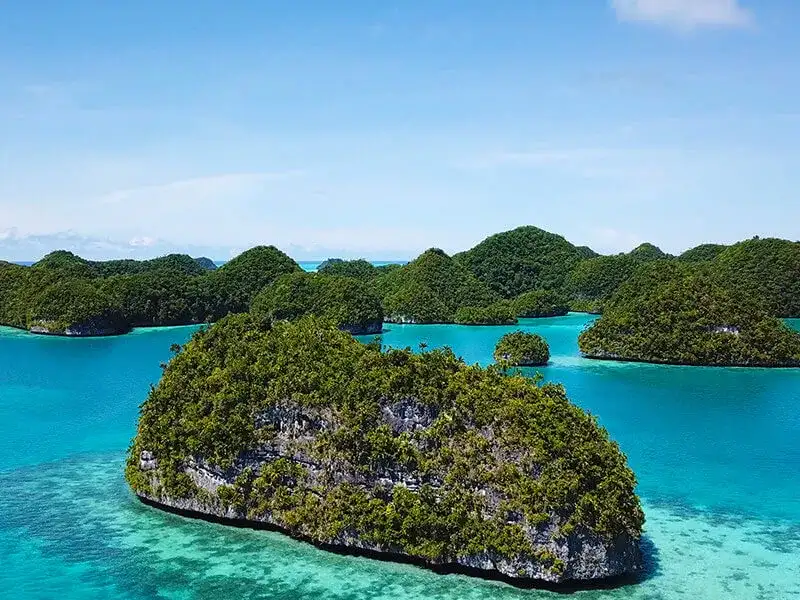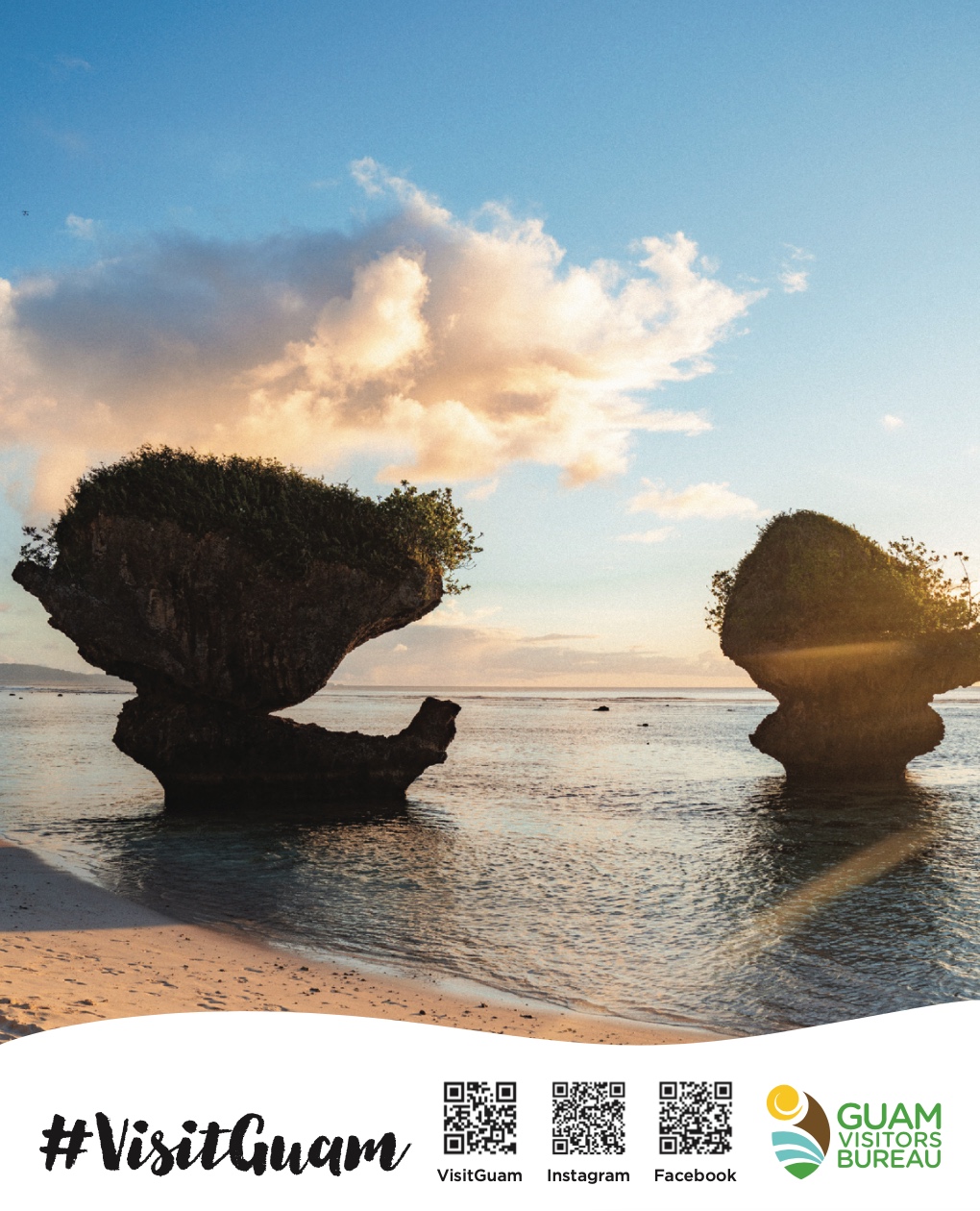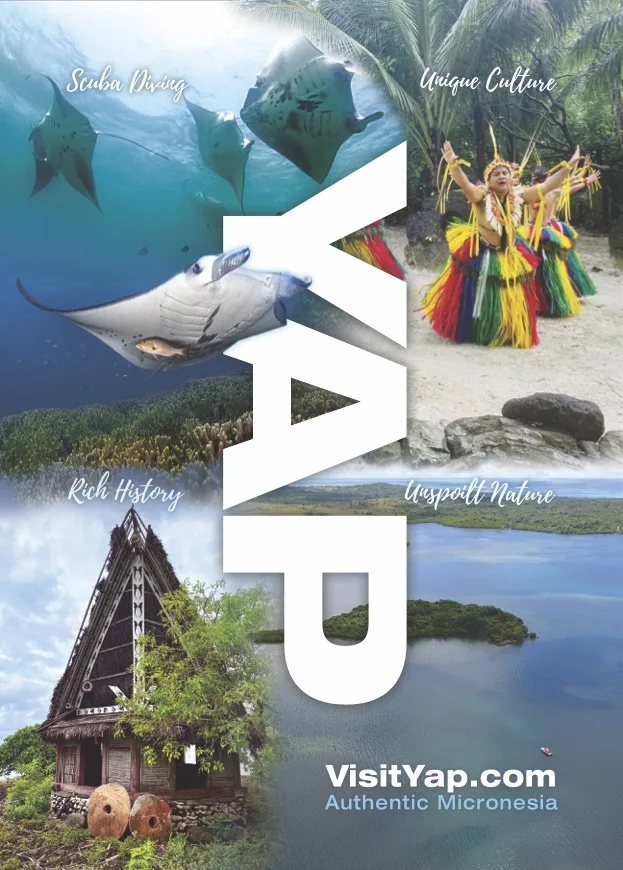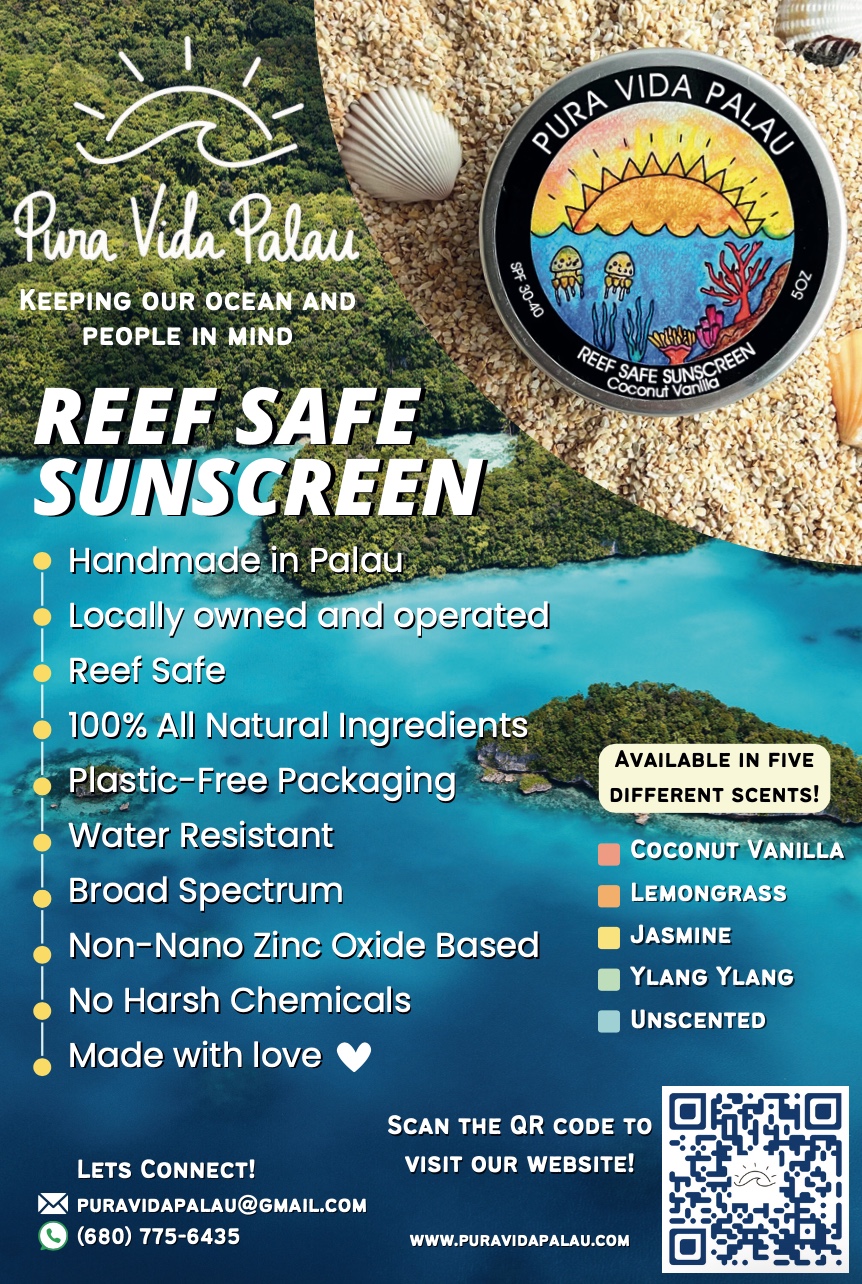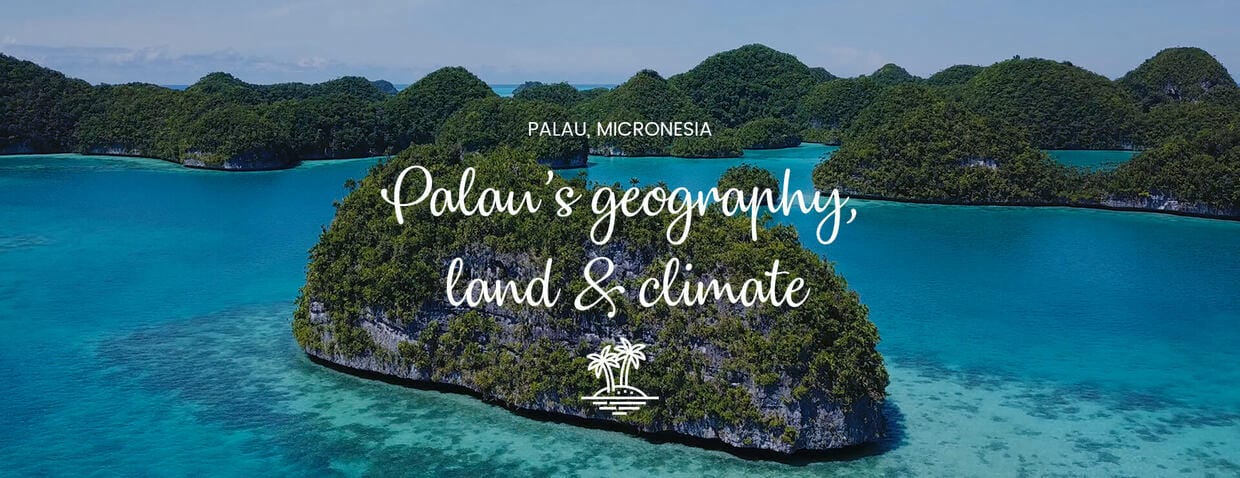
PALAU’S GEOGRAPHY, LAND & CLIMATE
An archipelago consisting of some 340 coral and volcanic islands, Palau, Micronesia, is located in the western Pacific Ocean. It is 1,330 km from Guam, 650 km from New Guinea, and 890 km from the Philippines, with a huge barrier reef system encircling most of the archipelago.
The major populated islands are Babelthuap (Babeldaob), Koror, Malakal, Arakabesan, and Peleliu. The Kayangel Islands to the north of Babelthuap are sparsely populated, and the raised coral islands of Angaur, Sonsorol, Pulo Anna, and Tobi can be found south of Peleliu Palau.
Koror Island is the most densely populated of the islands, and home to Koror City. Koror City was at one time the capital of the country, and remains the largest population centre. It is located just 628 metres south of Babelthuap Island, home of Melekeok, the capital since October 2006.
The land
Most of Palau’s lands are contained within a lagoon, bordered by 115 km of barrier reef.
Babelthuap is the largest of the islands, at 396 square km of volcanic rock, mainly andesite. The landscape is thick mangrove forest, sandy beaches, and a mountain range (Ngerchelchuus) reaching as high as 242 metres. Babelthuap is a rolling upland of grassland and jungle.
Babelthuap and Koror are connected by a steel bridge, and Koror in turn is linked by causeway to Malakal Island, to Palau’s deepwater port, and to Arakabesan Island. This 18 square km connection plays a key role in Palau’s economy and infrastructure.
There are more than 300 verdant rock islands, uplifted reef structures of coralline limestone, in the 45 km lagoon linking southern Babelthuap and eastern Koror and Peleliu. Each of the islands is deeply undercut at sea level, with some towering up to 180 metres. A number of the islands have interior brackish lakes, connected to the lagoon by subterranean channels and home to unique organisms. There is plentiful plant growth on the rock islands.
The limestone islands have rich deposits of phosphate, and the more accessible of these have been mined. Both German and Japanese settlers extracted phosphate from Angaur, for example.
Coral islands sitting on volcanic substructures, the Kayangel Islands are 40 km north of Babelthuap, and Angaur is 10 km south of Peleliu. The tiny islands of Sonsorol, Pulo Anna, and Tobi are located 290 km southwest of the Palau archipelago.
The climate
Palau benefits from a tropical climate, seeing rainfall of 3,050 to 4,060 mm per year and fairly constant humidity, ranging from 77 to 84 percent. Temperatures tend to hover around the low 80s °F (28 °C), with variations of plus or minus 10 °F (5.5 °C). The monsoon season runs from June to October.
Despite lying just 48 km from the deep Palau Trench, the western boundary of the upthrusting Pacific Plate, Palau sees few earthquakes.
Palau is regarded as being among the world’s premier scuba-diving locations.
Plant and animal life
Palau’s tropical climate and marine environment play host to rich and abundant flora and fauna. The country is home to more species of marine life than any other similar-sized region on earth.
Its marine life includes corals, fish, snails, clams, sea cucumbers, starfish, sea urchins, sea anemones, jellyfish, squid, and feather-duster worms. Common flora includes beach morning glory, Polynesian ironwood tree, pandanus, and various species of palm and fern.
Beautiful exotic birds migrate through Palau twice annually, and on the ground are reptiles, amphibians, insects, and a unique frog that gives birth to live young.
PALAU’S GOVERNMENT & ECONOMY
A brief history of Palau
The ancient history of Palau, Micronesia remains visible on Babelthuap, with its large hillside terraces, stone ruins, and megaliths. It is believed the islands were first settled between 2,000 and 4,000 years ago.
The islanders first contact with Westerners, however, occurred in 1783 after the shipwreck of the East India Company’s Antelope. The islanders’ welcome was evidently warm and friendly, and the events were detailed in George Keate’s An Account of the Pelew Islands (1788).
For the next century, the islanders had many Western visitors, largely whalers and traders, some of whom left behind beachcombers and firearms. They also brought with them unfamiliar diseases, some of which led to the deaths of infected islanders. In addition, the firearms were utilised in intervillage warfare.
In the late 19th century, Britain, Spain, and Imperial Germany claimed ownership of the islands. This dispute was mediated by Pope Leo XIII, who decreed that Palau should become part of the Spanish East Indies and economic concessions granted to Britain and Germany.
With this period of European colonisation came Roman Catholic missionaries and the beginning of Palau’s gradual transition from its traditional religions of ancestor worship and nature spirits to Christianity.
Germany was expelled by Japan at the beginning World War II, and then Japan itself lost control of the islands in World War II. The Japanese administration is remembered as a time of economic development and order, albeit a period in which the native population was reduced to a tiny minority.
The Japanese expulsion was followed by a short spell of administration by the US Navy, before Palau joined the United Nations Trust Territory of the Pacific Islands under US administration in 1947.
In 1981, Palau adopted its new constitution, modelled on the Constitution of the United States. The country held its first elections and officially became internally self-governing the same year. However, the first president, Haruo I Remeliik, was assassinated just four years later in 1985. The term of his replacement, Lazarus E. Salii, then ended early, when Salii committed suicide in August 1988. By the early 1990s, however, Palauan politics had stabilised.
The Compact of Free Association with the US was signed in 1982. The Compact obliged the US to take responsibility for Palau’s external security and defense and to provide financial assistance.
However, it also gave the US permission to operate nuclear-powered and nuclear-armed vessels and aircraft within the islands’ jurisdiction, and further, to neither confirm nor deny the presence or absence of such weapons. Following several failed attempts to revise the constitution and/or the compact agreement, the US dissolved the trusteeship in 1986.
In 1992, the islanders approved an amendment that declared a simple majority in a popular vote sufficient to override the antinuclear provision of the constitution. The Compact was fully approved by referendum the following year.
Palau became an independent nation in October 1994 and joined the UN in December 1995.
In September 1996, there was a disastrous incident in Palau, when the bridge connecting Koror and Babelthuap Island collapsed, killing two islanders. In addition, the incident left the capital city cut off from the international airport on Babelthuap, the rest of the country, and indeed the outside world in general for some time. There were also major disruptions to telecommunications, water, and power.
Ultimately, the Japanese government contributed 25 million USD for the construction of a replacement bridge. The new construction linking Babelthuap and Koror was of a suspension design, rather than a concrete cantilever like the original, and was opened some six years later in 2002.
Find a more in-depth history of the country at Everything You Need to Know about Palau.
Government
The highest elected offices in Palau, Micronesia are those of the president and vice president. There is also a two-house National Congress and a judiciary.
The country comprises 16 states, each a group of historic village-states. And each state is represented by a council of chiefs, which advises national government. The Ibedul of Koror and the Reklai of Melekeok are the paramount chiefs of Palau.
The National Congress is named the Olbiil era Kelulau (House of Whispers), symbolising the process of quiet consensus rather than adversarial public debate. And the judiciary comprises the Supreme Court, the Court of Common Pleas, and the Land Court.
There are no political parties. All citizens over the age of 18 have the right to vote.
Palau has no armed forces, and the country is protected militarily by the USA. Some young Palauans are volunteers in the US Armed Forces.
Economy
The largest employer in Palau is the government. The subsistence economy remains vital in the rural districts, with women farming taro, sweet potato, and cassava, and men fishing and tending pigs.
The government makes small sums from the sale of licenses for offshore tuna fishing and nearshore reef fishing. Traditional carved storyboards are still produced by local people, and nowadays mainly sold to visitors. Tuna and clothing are the country’s key exports, and the country relies heavily on financial assistance from the USA.
Outward migration has historically been higher from Palau than other countries in Micronesia. As a consequence, there are large Palauan communities found on Guam, in Hawaii and on the west coast of the USA.
In the latter half of the last century, however, inward migration grew as visitors arrived seeking work on the islands. Tourism also grew considerably over the same period, increasing from just over 23,000 in 1990 to almost 55,000 in 1999. Tourism is the country’s fastest growing industry and has made huge contributions to the country’s economic growth. Tourism contributed 65 million USD to the economy in 1995.
By the beginning of the 21st century, immigrants made up more than a quarter of the population and tourists outnumbered locals at high season.
Palau has earned a reputation as one the premier diving locations in the world, and thousands come from all corners of the globe every year to dive in Palau. As a result, there is now a vast range of resorts in Palau, from the high-end to the cheap-and-cheerful. You can get some idea of the selection here at Where to Stay in Palau.
Land tenure and property
Historically, lands, titles, and wealth were held by the clans and controlled by elders. Each clan controlled taro fields, a named house plot, and other lands, with some lands reserved for sharing by the village for example, the plots for chiefly meetinghouses.
The majority of the lands were alienated during colonial control, and only returned to the control of Palauans in the 1980s. Today, land can only be owned by Palauan citizens.
Social welfare and change programmes
The constitution of Palau, Micronesia mandates a strong programme of health and educational support.
Education is free and mandatory and there are support services for those who do not graduate. Private religious elementary and high schools are funded through a combination of school fees and government contributions.
Medical services are provided at low cost through the Belau National Hospital and several private medical clinics, and retirees benefit from both government and private retirement programmes.
PALAUAN SOCIETY
Demography
In 1995, the resident population of the country was 17,225. 71 percent of people were living in urbanised areas.
Prior to European contact, the population was closer to 50,000. This had been reduced to just 3,700 by 1900. Population growth accelerated between 1945 and the 1960s, though this was counterbalanced by outmigration. Today, 7,000 Palauans live overseas.
In 1973, immigrants made up just four percent of the country’s permanent population. By 1995, this had increased to 25.5 percent. The largest group was that of the Filipinos (2,654), followed by other Asians (738), Americans (535), other Micronesians (467), and Pacific islanders (232). By 1999, the number of Asian workers had increased to 5,250.
Ethnic Relations
The Palauan conceptualisation of ‘being Palauan’ is inclusive, incorporating long-term residents according to local custom. Similarly, the nation’s constitution confirms the citizenship of all those of Palauan heritage, regardless of birthplace.
Having enjoyed a diverse population throughout its long history, Palauan culture is open and welcoming to foreigners. The population has included Malays from Indonesia, Melanesians from New Guinea, Philippine natives, and some Polynesians from outlying Polynesian islands in Micronesia.
Since the end of the 18th century, there have also been visitors and migrants alike from Europe, Japan, and the USA.
Languages
The origins of the name ‘Palau’ are not known, but it is believed to either be derived from the Palauan word for ‘village’ (beluu, pronounced pelew) or the Spanish word for ‘mast’ (palao).
The Palauan language is complex, including many irregularities that make it extremely difficult to learn. Luckily for its learners though, both Palauan and English are regarded as official languages in all but two states, and many islanders are also fluent in Japanese and Tagalog. (The official languages of Sonsorol and Hatohobei are Sonsorolese and Tobian, respectively.)
Palauan has incorporated a number of Spanish, German, Japanese, and English loanwords.
Religion
The indigenous religion of Palau is one of powerful ancestor worship and nature spirits. This was largely supplanted by Christianity when European missionaries arrived, and today 65 percent of the islanders are Catholic. A further 25 percent are Protestant, and the remainder are members of other Christian denominations, Shinto, Buddhism, and Chinese folk religions.
However, Palauans continue to recognise traditional gods and their totemic embodiments, and refrain from eating clan totems. Major Christian rituals and holy places are recognised alongside indigenous village-based shrines. Funerals remain a key Palauan ritual.
Visitors should note that the head is considered a sacred body part in Palauan culture. So, it should not be touched, even as a sign of endearment for small children.
Class, castes and division of labour
Historically and up to the present day, men and women of all ages have taken responsibility for most basic productive tasks. They then moved into senior positions in the clan and village as they aged.
Today, the main division of labour is along the lines of nationality. Palauans and southwest islanders hold the key positions in the governmental sector, in management and the professions. Workers of Filipino and Chinese ethnicity tend to work in production and service occupations.
In the past, the seniority of a clan tended to be related to its wealth, and members of the highest ranking clans would control state and village resources as well as those of their own clan. Their leaders took responsibility for supporting descendants and dependents.
The chiefly system is now in decline and being replaced by systems of stratification based on education have arisen alongside increased participation in the world economy.
Historical symbols of social stratification might be along the lines of women wearing money pieces around their necks and chiefly men wearing dugong (sea cow) vertebrae bracelet or adze. Today, these symbols have been replaced by expensive clothing, houses, speedboats, and four-wheel-drive cars.
Medicine and healthcare
Healthcare in Palau is provided by Belau National Hospital on Koror, with services supplemented in more remote areas by field dispensaries and private clinics.
Traditional interventions based on leaves, herbs, and massage are in common use, with Western medicine also fully incorporated.
Secular celebrations
A range of national holidays are celebrated in Palau. Constitution Day occurs on 9 July. An Independence Day is marked. And there are numerous American holidays and an extended period of Christmas and New Year celebrations.
FAMILY, GENDER AND EDUCATION IN PALAU
Division of labour by gender
Historically, the division of labour in daily work was strongly gendered. Men took responsibility for fishing and the construction of houses and community buildings, whilst women were in charge of farming and shellfish collection.
Today, men and women are active in wage labour, including the professions, although national political offices are rarely held by women. Just one woman has been elected to the Palau Supreme Court.
The relative status of women and men
Traditional Palauan culture promotes complementary roles for men and women. The governing village council was male, with a female chiefly counterpart council. Senior women were integrally involved in leadership, with influential positions in clan decision-making.
The society has historically been matrilineal, with money, land and titles entering the clan through the woman. Changes to the law of inheritance, however, are eroding this power. Social security payments and intestate estates will now be transferred to a widow and her children, a major transformation of inheritance practices.
Marriage
Traditional Palauan marriages were arranged. This has now largely been supplanted by ‘love marriage’, with individuals may select their own partners. Divorce is increasingly common, particularly among young islanders.
Marriage is formalised by a court or church, with traditional ceremonies involving clan exchanges of prescribed foods and wealth. Where traditional households tended to comprise three or four generations of family members, modern families tend to be nuclear families.
Child rearing and education
A special ceremony is held to celebrate the birth of a Palauan woman’s first child. In this ceremony, the female elders gather and organise a series of hot baths, effectively presenting the young woman to the community.
Care of infants tends to be shared among female relatives, who bring the child to the mother for nursing. Men are also involved in child care, particularly that of young boys.
A formal education system for children has replaced the traditional methods of learning by observing adults at work. Education is mandatory and typically begins with kindergarten, followed by elementary and secondary schools.
Two-year vocational and academic courses at Palau Community College are available to students throughout the region, preparing islanders for the four-year systems of Guam and the USA. There are no higher educational institutions in Palau, but there are government scholarships for those who wish to study abroad.
Teaching is in both English and Palauan and the country has near-total adult literacy rates.
CULTURAL LIFE IN PALAU
Traditional art forms persist in Palau, commonly in the form of chants and storyboards. However, the carved storyboards are now designed and made for sale to tourists, rather than for decoration of men’s clubhouses.
The Belau National Museum was opened in 1955 on Koror and is home to a small but instructive collection of artefacts. Etpison Museum, also on Koror, was opened in 1999 and has an array photographs, maps, and cultural pieces. Palau has twice sent delegations to the Pacific Festival of Arts and hosted the 2004 festival.
The Palau Ministry of Community and Cultural Affairs which includes the Palau Historic Preservation Office, Belau National Museum, and Ministry of Education operates aggressive programmes in cultural conservation, counteracting strong American influences in education.
Sporting activities are perhaps the strongest draw to Palau. Many tourists come to Micronesia to dive in Palau, and there is a wealth of holiday resorts in Palau and diving tours, as well as the famous Palau Shark Week.
The Arts and Humanities
Poetry is the most developed of the Palauan literary arts, with poetry commonly created in both Palauan and English. There are many well-known poets among the islanders, though little of their work is available in published form.
The graphic arts are also highly developed. Historically, the village meetinghouse was the centre of visual and performance arts. The end gables (bai) and interior beams were decorated with low-relief painted carvings, depicting the history of the village and its relationships with other villages.
Carved wooden storyboards are a highly developed art form, today primarily produced for sale to foreigners. The carvers of these storyboards, as well as shell jewellery makers and weavers, are potentially able to earn substantial income from these practices.
Dancing is a popular art form, with traditional dances performed by village groups and informal dancing common in village meetings. Similarly, oratory is a traditional form that remains highly popular. Senior elders typically perform historical chants and pieces from a range of musical genres. Contemporary Palauan music is composed for broadcast in nightclubs and on public occasions.
Design & architecture
The community meetinghouse (bai) was once central to Palauan politics, society, and culture. Although this is no longer the case, the decorated bai gable, or canopy, still appears in many island buildings. These include village properties and urban buildings.
A frequently spotted historical design feature is a quartered circle representing wealth. There is also a half-shell symbol that represents Palauan lore of the creation of humanity from the sea. Images of the mother and child symbolise wealth and fertility.
Palau’s symbols of nationhood include its national flag and anthem, and a full golden moon on a blue background.
The physical and social sciences
Palau, Micronesia has developed a reputation for marine biology research. The scientific skills of Palauan master fishermen have been utilised in the field, and scientists at the Micronesian Mariculture Demonstration Center were the first to successfully spawn giant clams in a lab and to develop programmes to build stocks of endangered hawksbill turtles.
The Palau International Coral Reef Center for scientific research, coral reef management, and educational programmes opened in 2001.
Food in Palau
Food plays a central role in Palauan culture, being commonly used to express respect for elders, celebrate the birth of a child, and mark the death of a clan member, as well as in a wide range of social and spiritual ceremonies. See Palauan Cuisine for a more detailed exploration of Palauan cuisine and food.
Food is the basis of a strong domestic economy in Palau. The protein (odoim) is typically provided by the men and the starch (ongraol) by women. There are food taboos in different clans, and traditions around eating for titled individuals and for pregnant and lactating women.
A basic meal in Palau comprises a starch food perhaps soft or hard taro, tapioca, or imported rice and a protein, normally fish or pork. Breakfast typically comprises coffee and bread or cereal.
The breadfruit (ulu) is very common, and coconuts are used in a variety of ways. Taro, yams, pumpkins, and other root vegetables are found in most meals. Exotic fruits are plentiful, including passionfruit, breadfruit, dragon fruit, papaya and mango, soursop, and the superfruit, rambutans.
Local diets are today very multicultural. Koror is home to an eclectic range of restaurants, offering Korean, Chinese, Indian, and Western cuisine, and fine Japanese sushi and sashimi.
Western food is often preferred by younger islanders, and branches of KFC and McDonald’s and USA-style barbecue pub and grills can now be found across all major population centres.
A drink of molasses created from coconut sap is served to chiefs and elders. This is thought to offer medicinal benefits and is imbued with religious significance.
For more information contact
Palau Visitors Authority
Address: PO Box 256, Koror, PW 96940
Phone: +680-488-2793/1930
Email: pva@pristineparadisepalau.com
Website: www.pristineparadisepalau.com
Fax: +680-488-1453

